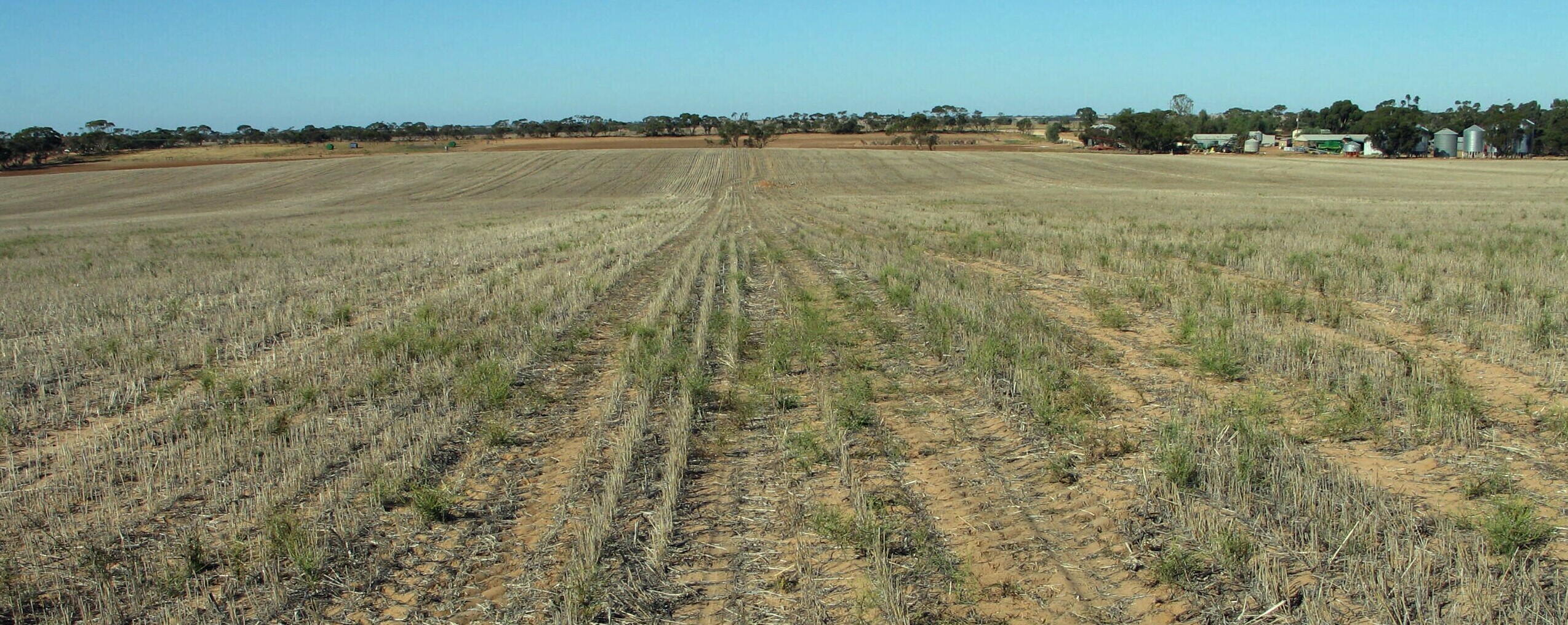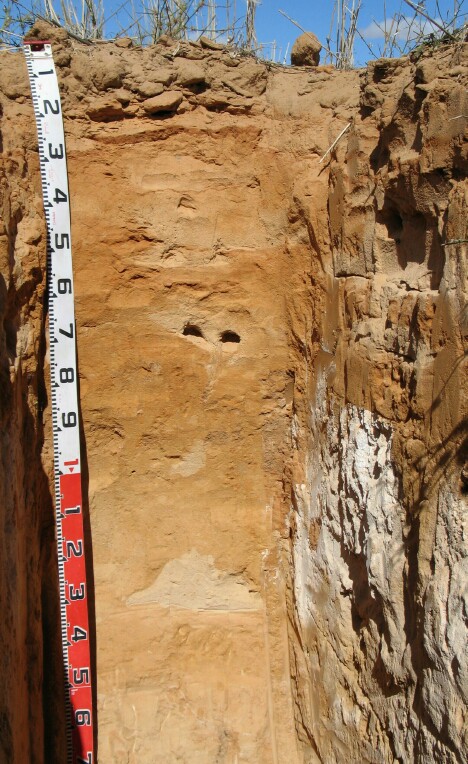NTF4
| Aust. Soil Class.: Calcareous, Argic, Yellow-Orthic, TENOSOL | |
| General Landscape Description: Crest of east-west trending dune (approximately 5 m above site NTF3). | |
| Site Description: Stubble paddock | Geology: Quaternary (Woorinen Formation) aeolian deposits |
| Vegetation: Mallee | |
 NTF4 Landscape |
Soil Profile Morphology:
Surface Soil
| A | 0-15 cm | Brown (7.5YR5/4); loamy sand; single grained; very weak consistence (dry); pH 7.4; abrupt change to: |  NTF4 Profile |
| A12 | 15-22 cm | Reddish yellow (7.5YR6/6); loamy sand; massive; weak consistence (dry); pH 6.7; sharp and wavy change to: | |
| Subsoil | |||
| B1 | 22-25 cm | Reddish yellow (5YR6/6); clayey sand; massive; strong consistence (dry); pH 7.1; non-effervescent; abrupt and wavy change to: | |
| B21 | 25-50 cm | Reddish yellow (7.5YR7/6) (7.5YR7/4 dry); loamy sand; massive; weak consistence (dry); variable argillaceous bands; minor banks; pH 7.5; abrupt and irregular change to: | |
| B22 | 55-75 cm | Reddish yellow (7.5YR6/6); clayey sand; with occasional pockets of bleached loamy sand; massive; very firm consistence (dry); pH 7.9; sharp and broken irregular change to: | |
| B23k | 75-130 cm | Reddish yellow (7.5YR6/6); clayey sand; massive; very firm to rigid consistence (dry); very many (>50%) extremely coarse (>60 mm) calcareous nodules with pockets of fine-earth carbonates; pH 9.0; clear and discontinuous change to: | |
| B24 | 130-160 cm | Reddish yellow (7.5YR7/6); clayey sand; massive; very firm consistence (dry); few (2-10%) fine (<2 mm) soft calcareous segregations, with bands of fine-earth carbonates; pH 9.2; gradual and wavy change to: | |
| B25 | 160-200+ cm | Reddish yellow (7.5YR7/6); clayey sand; massive; very firm consistence (dry); few (2-10%) fine (<2 mm) soft calcareous segregations; pH 9.5. |
Key Profile Features:
- Soil profile sandy throughout
- Variable accumulations of calcareous segregations (lime) in deeper subsoil
pH | Salinity Rating | |||
Surface (A1 horizon) | Slightly Alkaline | Very Low | Non-Sodic | None |
Subsoil (B21 horizon) | Slightly Alkaline | Very Low | Non-Sodic | None |
Deeper subsoil (at 160-200+ cm) | Very Strongly Alkaline | Low | Non-Sodic | None |
 |
Horizon | Horizon Depth | pH (water) | pH CaCl2 | EC 1:5 | Org. Carbon mg/kg | Exchangeable Cations | |||
Ca | Mg | K | Na | ||||||
Meq/100g | |||||||||
A11 | 0-15 | 7.4 | 7.1 | 0.12 | 2.0 | 0.61 | 0.14 | <0.05 | |
A12 | 15-22 | 6.7 | 6.3 | 0.05 | 1.5 | 0.56 | 0.06 | <0.05 | |
B1 | 22-25 | 7.1 | 6.5 | 0.06 | 3.5 | 1.3 | 0.19 | <0.05 | |
B21 | 25-50 | 7.5 | 6.9 | <0.05 | 1.2 | 0.48 | <0.05 | <0.05 | |
B22 | 55-75 | 7.9 | 7.2 | 0.05 | 3.8 | 2.3 | 0.12 | 0.09 | |
B23k | 75-130 | 9.0 | 8.4 | 0.13 | 1.6 | 0.48 | 0.14 | 0.10 | |
B24 | 130-160 | 9.2 | 8.6 | 0.11 | <0.01 | ||||
B25 | 160-200+ | 9.5 | 8.8 | 0.13 | <0.01 | ||||
Horizon | Horizon Depth | Boron mg/kg | Field pF2.5 g/100g | Wilting Point pF4.2 g/100g | Coarse Sand (0.2-2.0mm) % | Fine Sand (0.02-0.2mm) % | Silt (0.002-0.02mm) % | Clay (<0.002mm) % |
A11 | 0-15 | <0.3 | 4.9 | 1.5 | 61 | 33 | 1 | 5 |
A12 | 15-22 | <0.3 | 4.3 | 1.6 | 53 | 40 | 2 | 5 |
B1 | 22-25 | 0.3 | 10.4 | 4 | 51 | 36 | 2 | 8 |
B21 | 25-50 | <0.3 | 5.9 | 1.4 | 54 | 40 | 1 | 3 |
B22 | 55-75 | 0.5 | 11.4 | 4 | 51 | 36 | 0 | 10 |
B23k | 75-130 | 1.0 | 20.1 | 6.3 | 39 | 28 | 12 | 15 |
B24 | 130-160 | |||||||
B25 | 160-200+ |
Management Considerations:
Whole Profile
- Management strategies for all soils should aim to increase organic matter levels in the surface soil; minimise the degradation of soil aggregates and porosity; promote the development of stable biopores; improve the calcium status of the cation exchange complex (particularly when sodium is a significant part), and break up any hardpans. Less frequent tillage; using less aggressive implements, and working the soil at optimum moisture content can all assist in maintaining soil aggregation and porosity as well as reducing the breakdown of organic matter.
- The surface horizons have a low water holding capacity and are likely to become 'droughty' during periods of low rainfall. The low wilting point value (i.e. <2), however, indicates that plants will be able to utilise light rains falling on relatively dry soil. Heavier (i.e. more clayey) soils need to have considerable moisture stored before plants can have access to it.
- The surface soil has a low inherent fertility due to the high sand content and low clay content. Leaching of applied fertilisers is likely to be relatively high. Maintaining and improving organic matter levels are important for enhancing fertility, soil aggregation and water holding capacity.
- Infiltration rates are likely to be relatively high for the sandy surface horizons.
- The sandy subsoil also has an overall low water holding capacity. However, in some areas there are accumulations of clay in the sand that will enhance water holding capacity and fertility – compared to deep sandy soils without these clay accumulations.
- The deeper subsoil (from 75 cm depth) becomes strongly to very strongly alkaline. This indicates that indicates that phosphorus and trace elements such as iron, manganese, zinc and copper may be poorly available for plants. Deficiencies can be determined by plant tissue analysis. Levels of exchangeable boron can also become toxic in strongly alkaline subsoils in the Mallee region. Boron levels measured at this site, however, are low and not likely to affect boron-sensitive plants.
Profile described by Mark Imhof and David Rees (April 2005).


